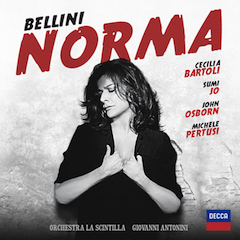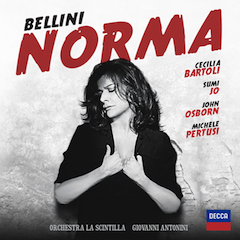
Move over, Wagner, Verdi, Britten, Gesualdo, George Lloyd, Stravinsky’s The Rite of Spring, and other centenary celebrants. Cecilia Bartoli’s jaw-dropping account of Vincenzo Bellini's 1831 opera Norma is just as important as the great recordings of your masterpieces. Released on June 11 in CD and two download formats, high-resolution (on HDTracks) and “Mastered for iTunes,” this Norma is the culmination of the great mezzo’s latest research. Radically different in conception and execution from the famous recordings by Sutherland (No. 1 from 1964), Callas (many to choose from), and Caballé (unmissable as Norma in the live-from-L’Orange DVD, and equally exquisite as Adalgisa in Sutherland 2), Bartoli’s Norma is a force to be reckoned with.
Using a new critical edition that Maurizio Biondi & Riccardo Minasi compiled from Bellini’s autograph score, Bartoli and period instrument Orchestra La Scintilla adhere to Bellini’s original keys and tempos. Tuning is 430 rather than the more brilliant, modern 440, and dynamics and phrasing reputed to be Bellini’s. This translates into a faster and lower sounding Norma than we’re accustomed to hearing.
While Bartoli came to Norma through her research on the singer Maria Malibran, whom Bellini adored, much of her inspiration for embellishment came from Bellini’s chosen Norma, Giuditta Pasta. Both women might be considered mezzo-sopranos by today’s standards. Bartoli studied manuscripts of ornamentation from singers who were taught by Pasta before formulating her own.
Adhering to Bellini’s casting preferences, Adalgisa is a soprano, Sumi Jo, rather than a heavy-voiced mezzo. Adalgisa’s gorgeous duets with Norma, where Jo’s lighter and slimmer voice seems to fold into the center of Bartoli’s as a honeybee would merge into the center of a fragrant flower, are a distinct high point of the recording.
Without a doubt, one opinion divider will be Norma’s opening prayer, “Casta Diva” (Chaste Goddess), and its rousing cabaletta, “Ah! bello a me ritorna” (Ah, come back to me). Not only is “Casta Diva” preceded by a key modulation — Bellini’s, we’re told, but jarring nonetheless — but its second verse is also sung with enough eyebrow raising variations to suggest that Norma was never the chaste Priestess her followers expected. After multiple listens, I remain unconvinced that the variations completely serve Bartoli’s characterization rather than her need to demonstrate what a phenomenal singer she is. (She does, and she is.) But that was the norm in the early 19th century, and Bellini went along for the ride.
Regardless, the feeling at the core of Norma’s prayer is expressed with a heartfelt sincerity often missing from other versions, and the middle section coloratura is performed with far more imagination and grace than usual. Another striking aspect of Bartoli’s limpid execution is how often she goes from mezza voce (moderate volume) to pianissimo rather than forte. She perfectly voices high notes without ever lingering — Sumi Jo employs an equally light touch on high — yet ends “Casta Diva” by disappointingly going down rather than up. I suppose the soft ending is more fitting for a prayer, but I miss the glory of a softly floated, luminescent high note that swells the way Claudia Muzio voiced it almost 80 years ago.
Tempos sometimes startle. Forget the stately procession that often ends Norma’s opening scene; Bartoli exits at a fast clip. Given how many singers and stage directors don’t know what to do with the usual lethargic pacing, that isn’t a bad thing, but it is unsettling. Again, we’re assured that this is what Bellini indicated in his greatly marked up score.
Characterization is supreme. Bartoli’s Norma may have her fair share of bubbling anger, but the vulnerability at the core of her beautiful, oft plangent sound makes her ultimate self-sacrifice far more plausible than that of the monumental Sutherland or bile-filled Callas. Jo’s Adalgisa is the epitome of fragile innocence, and far more believable for that. There’s less to say about John Osborn’s light-voiced Pollione, which fails to grab me, or Michele Pertusi’s somewhat wooly Oroveso, if only because Norma is so clearly a two-women show.
The engineering is disappointing. Recorded in Evangelisch-reformierte Kirchgemeinde in Zurich, there is so much resonance around voices, even when produced softly, as to make it impossible to extrapolate their actual size. Nor is the recording the ultimate in transparency, three dimensionality, and warmth. There’s an overriding sense of too many microphones, and far too much post-production, digital tinkering.
Nonetheless, the emotion of Bellini’s music comes through. This Norma may confound expectations, but the finesse, sincerity, and depth that Bartoli and Jo bring to their roles will stay with you long after the recording’s authentic novelty has subsided. Even as Sutherland and Callas jockey for supremacy, and Caballé floats heavenly above the fray, Bartoli and Jo may steal your heart.



